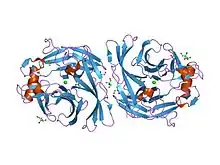Apyrase
Apyrase (EC 3.6.1.5, ATP-diphosphatase, adenosine diphosphatase, ADPase, ATP diphosphohydrolase) is a calcium-activated plasma membrane-bound enzyme (magnesium can also activate it) (EC 3.6.1.5) that catalyses the hydrolysis of ATP to yield AMP and inorganic phosphate. Two isoenzymes are found in commercial preparations from S. tuberosum. One with a higher ratio of substrate selectivity for ATP:ADP (approx 10) and another with no selectivity (ratio 1).
| Apyrase | |||||||||
|---|---|---|---|---|---|---|---|---|---|
 structure and protein design of human apyrase | |||||||||
| Identifiers | |||||||||
| Symbol | Apyrase | ||||||||
| Pfam | PF06079 | ||||||||
| InterPro | IPR009283 | ||||||||
| SCOP2 | 1s1d / SCOPe / SUPFAM | ||||||||
| Membranome | 581 | ||||||||
| |||||||||
It can also act on ADP and other nucleoside triphosphates and diphosphates with the general reaction being NTP -> NDP + Pi -> NMP + 2Pi. This is the same activity that has been employed in the degradation of unincorporated nucleosides during pyrosequencing.
The salivary apyrases of blood-feeding arthropods are nucleotide hydrolysing enzymes that are implicated in the inhibition of host platelet aggregation through the hydrolysis of extracellular adenosine diphosphate.[1]
References
- Smith TM, Hicks-Berger CA, Kim S, Kirley TL (October 2002). "Cloning, expression, and characterization of a soluble calcium-activated nucleotidase, a human enzyme belonging to a new family of extracellular nucleotidases". Arch. Biochem. Biophys. 406 (1): 105–15. doi:10.1016/S0003-9861(02)00420-4. PMID 12234496.